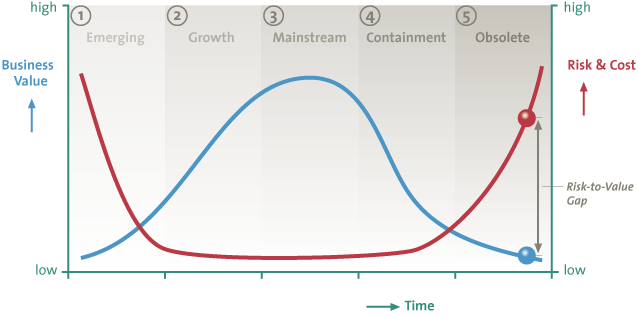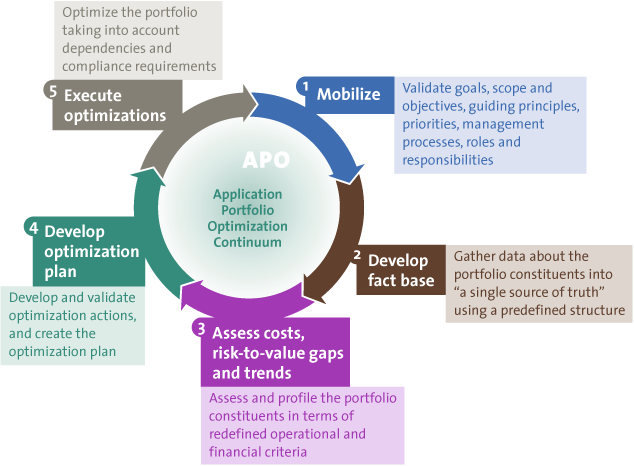The past few years have seen significant changes in the enterprise applications landscape. Along with emerging innovative technologies such as mobile, analytics, social and cloud computing, the management processes, methods and tools for managing applications have also evolved, enabling suppliers to provide more and better functionality. In addition, the Everything-as-a-Service (XaaS) model has made the procurement and consumption of IT services more convenient and affordable, boosting demand for more applications that increase the complexity of technology inventories and expectations of IT. We believe that CIOs can mitigate this problem by executing Application Portfolio Optimization (APO) – a framework for managing the organization’s technology inventories with a view to optimizing their value, reducing technology risk, improving operational efficiency, and re-directing investment from maintenance to innovation.
Introduction
The past few years have seen significant changes in the enterprise applications landscape. Along with emerging innovative technologies such as mobile, analytics, social and cloud computing, the management processes, methods and tools for managing applications have also evolved, enabling suppliers to provide more and better functionality. In addition, the Everything-as-a-Service (XaaS) model has made the procurement and consumption of IT services more convenient and affordable, boosting demand for more applications that increase the complexity of technology inventories and expectations of IT.
But as recent surveys show, the perception of IT has not improved and its role has not evolved with the current wave of innovation. On the contrary: according to a recent McKinsey survey ([Aran15]) among 362 IT executives and 350 non-IT executives, the current views of IT performance are decidedly negative. The survey also shows that there is little agreement on how IT can meaningfully shape the digital future of the enterprise: whereas non-IT executives expect better information to support planning and decision-making, IT executives continue to be concerned about reducing costs. And, possibly as a consequence of this, 20 per cent of firms responding to a recent CIO Survey report ([Harv15]) indicate that more than a quarter of their IT spending was controlled or managed from outside the IT organization, as compared with 14 per cent or more a year ago.
Our experience of working with clients provides more insights into the cause of this dilemma. Apart from the usual suspects – such as the chronic shortage of IT talent and IT’s perceived lack of business acumen – we found that many IT organizations are constrained by their complex and diverse inventory of applications, infrastructure components and services, which consume the majority of resources and leave little IT capacity to respond to digital disruption and actively shape the digital future of the enterprise.
CIOs can mitigate this problem by executing an Application Portfolio Optimization (APO) program to manage their organization’s technology inventories with a view to reducing technology risk, improving operational efficiency, and re-directing investment from maintenance to innovation. The idea is to make this part of the organization’s DNA, so that it becomes a sustainable and continuous improvement process that business and IT executives practice collaboratively; as a result technology portfolio bloat will not reoccur for several years to come.
Execute Active and Sustainable Application Portfolio Optimization
One of the most common divisions of work between business and IT is the demand and supply model that makes the business (demand) responsible for a variety of activities. These include articulating requirements, establishing project priorities and schedules, and allocating funding and IT (supply) responsible for managing the delivery and support of the organization’s portfolio of application and infrastructure services. What is often missing is a joint approach to monitor and assess applications over their life to provide relevant planning information and facilitate the collaboration between business and IT towards better technology decisions.
Organizations that have to make do without this approach have a hard time elevating IT’s performance to meet expectations. Apart from the inability to provide timely information for planning and decision-making, CIOs are frequently locked into executing large, ad-hoc rationalization and consolidation initiatives when management, in response to adverse economic conditions, implement mandatory across-the-board cost reductions; or worse, when the complexity and costs of maintaining the portfolios exceed IT’s capacity to manage them (see box).
Case Studies
Biotechnology Company Optimizes Its IT Consumption
The client was supporting a large number of enterprise applications that were expensive to maintain and reduced their return on investment for the software. It was also restricting its ability to be responsive to its business stakeholders and invest in new digital capabilities. The client undertook an initiative to simplify the application environment and set a goal to reduce their application portfolio by 20 to 30 per cent over the following years. Success would result in annualized savings of between $7 million and $10 million.
Utility Company Reduces the Application Footprint
A utility company realized that it was going to have to make sizable investments to leverage digitization and keep pace with competitors’ innovations. It became apparent that it needed to reduce its application footprint. Using a combined top-down and bottom-up approach, KPMG identified ways to reduce 20 to 30 per cent of the company’s portfolio by targeting functional redundancy and high-risk technology concerns. The application rationalization strategy also increased the company’s ability to forecast resources and improve the reliability and availability of business services.
Telecommunications Company Develops Application Portfolio Optimization Roadmap
A Fortune 500 telecommunications company recognized the need to streamline their IT platform. KPMG helped the client implement a strategy to analyze costs and savings at an aggregate level and focus on business capabilities. The team developed a roadmap and plan to reduce their application portfolio by 30 per cent over a four-year period. After three years, the company had reduced its application portfolio by 25 per cent. Key success drivers were an executive mandate and consistent governance for target reductions in each function. These factors were backed by a clear understanding of the overall business process complexities inherent in the application portfolio.
These reactive initiatives are disruptive as they typically lead to unpopular cost and personnel reductions, face resistance from stakeholders and require time, resources, specialized knowledge, and capital that should be invested in innovation rather than inventory cleaning. Even worse, many rationalization initiatives end up as “paper exercises”, where applications and infrastructure that were supposed to have been discontinued are later found to be still running, consuming resources, and adding unnecessary risk.
KPMG has developed an assessment and planning framework for client organizations to help them break the cycle of reactive rationalization and consolidation initiatives and replace them with a proactive and sustainable process. The framework, which has been validated during numerous client engagements, is aimed at increasing business agility and value from technology investments and improving the management of technology complexity. It is based on three practices:
- Assessing the value-to-risk gaps of applications over their entire life
- Engaging the business in a collaborative process to make decisions
- Embedding APO part of the organization’s DNA
Assess the Value-to-Risk Gap of Applications over their Life
When establishing APO, CIOs must ensure that the framework evolves into a sustainable capability that provides timely and accurate information about the costs, dependencies, value and risk of the organization’s applications. This information serves as a baseline for optimizing the portfolio as a whole. APO works well if it employs a business capability model to align business processes with their respective applications, underlying infrastructure components, and dependencies – and, in addition, to identify their owners and stakeholders.
Once the alignment is established, it becomes possible to determine the value and risk of each application and also monitor the changing relationship between risk and value throughout the application’s life. By providing the appetite for risk in context with value and time, APO can help the business and IT executives make better decisions.
It is important to understand that during their life cycle, most of the applications and related infrastructures in the portfolio progress through five stages, ranging from emergence to obsolescence ([Bish14a]). Across these five stages, the business value of an application will generally follow a curve that peaks in the mainstream phase, when the technology is proven, cost-efficient, and returning the highest value to the business (see Figure 1). Over the same life cycle, the risk and cost curve follows a “bathtub” shape: risks and costs tend to be higher at early stages, when technology is untested and deployment costs are high, and at the end-of-life, when the management has to address challenges such as interoperability and integration issues, declining functionality, lower than expected service levels, extended support contracts, increasingly expensive maintenance, and lack of skills and support on the part of vendors.

Figure 1. Business Value, Risk, and Cost over Technology Life Cycle (illustrative; source: KPMG).
Our experience is that many executives are better at managing the risk and cost associated with deploying applications than they are at managing risk and cost at the end of their life cycle. Part of the problem is that many organizations seriously underestimate or do not even know the cost or risk of operating older applications and infrastructure, and are unaware of the risk-to-value gap, which inherently opens during the containment phase and rapidly widens towards the end of the life cycle.
Building the process and tools for assessing the risk-to-value gap and communicating this information to decision-makers are critical aspects of APO. They are also difficult to implement. Most organizations do not collect the value and risk data, because their executives are unaware of the life cycle risks in their technology portfolios. In addition, many organizations have to deal with conflicting points of view in respect of need, priority, and value, as many legacy applications have large variations in the age and accuracy of their documentation. Poor governance further complicates this challenge, as the roles and responsibilities required to determine the value and risk information often remain unclear and accountability is absent.
Engaging the Business in Decision-Making
In order to address the information management and governance challenges discussed earlier, CIOs must ensure that the APO framework evolves into a collaborative process between IT and the business. This is a continuous improvement process based on five phases that moves through multiple iterations (Figure 2). However, getting started will require an initial effort to optimize the existing portfolio.

Figure 2. The five phases of APO development.
Step 1: Mobilize the team
Start by defining APO’s goals, scope, objectives, guiding principles, priorities and ways of working. Identify the business and IT stakeholders who need to contribute and help them develop a common understanding as to why APO is a sound concept, while gaining their commitment to participate. During subsequent iterations, the CIO works with the stakeholders to revisit and refine the process while gaining consensus on governance, organization, roles and responsibilities, resource allocations, and measurements.
Step 2: Gather the facts
This step begins with the conceptual definition of the portfolio structure. It also includes the mapping of all related IT services, processes and resources to business capabilities, to determine their functional role in the enterprise and any interdependencies. From an organizational point of view it is important that APO aggregates the fact base as “a single source of truth” using common language and categories, such as business value, cost, technical viability, vendor governance and related questions, with a view to structuring and describing its constituents.
Step 3: Analyze the data (assess costs, risk, value and trends)
Analyze the fact base to identify systems with high risk and cost levels, including technologies that are non-compliant with the corporate strategy, technically obsolete and/or add complexity and costs through unnecessary duplication. During this step APO also develops and refines a set of profiles describing the constituents that display high risk-to-value gaps. These profiles use a predefined structure based on operational and financial criteria. They must also include trends and anticipated changes, for example the termination of a vendor’s support contract.
Step 4: Develop the optimization plan
Develop a preliminary set of actions for handling changes to the portfolio. Some of these changes may concern technologies in the emerging phase, but many involve legacy applications and mitigating risk in technologies in the obsolescence phase of their life cycle. This step also requires the development of communication plans, including validation workshops with the application owners, users and suppliers to analyze the real impact of decommissioning, and ensure their buy-in and support.
Step 5: Execute the plan
This step includes the detailed planning and execution of all activities needed to successfully implement portfolio optimization, including the cancellation of current high-risk low benefit investments and replacement, modernization, or discontinuation of designated legacy systems. Detailed plans will take into consideration both technical and business activities. These include the design, build, test, and deployment of any data archiving solutions and validation of data for migration to the archiving solution when an application is discontinued, as well as any dependencies, such as a new system go-live.
Making APO Part of the Organization’s DNA
Once the portfolio has been optimized, the next step is to keep it that way. APO is not a one-time event conducted only when things are bad. Rather, it should be part of the IT governance process. Organizations that implement robust technology business management (TBM) are able to continuously measure and monitor the cost and value of applications and services and leverage a rich set of data to help make decisions. This makes APO a continuous and sustainable process. When embedded in this way, APO:
- Redistributes accountabilities. APO provides the mapping of all IT services, processes and resources to business capabilities to determine their functional role in the enterprise and any interdependencies. By profiling the applications in terms of their business value, costs and risks, APO helps the decision-makers identify who own the applications, understand their usage and criticality, and decide how to manage them in the context of the new model.
- Implements more financial discipline. APO tracks the life cycle of every application in the organization’s portfolio, from requirement analysis and initial investments to decommissioning. By providing recommendations, including the cancellation of current high-risk low benefit investments and replacement, modernization, or retirement of designated legacy systems, APO helps the business owners of applications implement the financial discipline required to maximize the portfolio’s business value.
- Improves stakeholder collaboration. APO aggregates the information about the organization’s technology inventories into “a single source of truth”, using common language and business-relevant categories to enable the communication between stakeholders, and facilitate their collaboration towards making better technology decisions.
There is no doubt that embarking on an initial APO program can require a significant amount of resources, time, and money. However, in a majority of cases this concerns a one-time investment, while the benefits of an optimized portfolio pay off year after year as described in the box above. Organizations facing resource constraints can take an incremental approach. Typically a small number of applications account for the majority of the high operating and maintenance costs. These applications should have the initial focus and will provide cost and resource savings that can be used to continue the program.
Conclusion
Organizations that adopt the portfolio management framework described earlier benefit from it beyond the promise of cost reductions realized through traditional rationalization and consolidation projects. The more sustainable benefits stem from APO’s ability to:
- Support business agility. APO directly supports the faster turnaround of innovations into new products as it proactively monitors all investments in technology to ensure that they are prioritized and supported through the best strategies that the organization can offer.
- Increase the value of technology investments during business change. APO proactively creates a unified fact base, monitors the overall business performance of the application inventories in terms of their value and risk, and provides directions and recommendations to increase their value.
- Support the continuous improvement in IT management. APO views applications as business assets, and provides insights into what executives need to know and do in order to better manage these assets through their life cycle.
- Improve IT governance. While transitioning from reactive rationalizations and consolidations into proactive portfolio optimization, APO facilitates the collaboration between business and IT executives and supports the gradual shift in accountability for technology decisions from the IT supply functions to the business owners of the technology portfolio.
References
[Aran15] P. Arandjelovic, L. Bulin and N. Khan, Why CIOs should be business-strategy partners, McKinsey, 2015, http://www.mckinsey.com/insights/business_technology/why_cios_should_be_business-strategy_partners
[Bish14a] M. Bishop, B.J. Brunsman and M.E. Snyder, Assess the Business Impact of Technology Obsolescence, KPMG, 2014, http://www.kpmg-institutes.com/content/dam/kpmg/advisory-institute/pdf/2014/business-impact-technology-obsolescence.pdf
[Bish14b] M. Bishop, M.E. Snyder, B.J. Brunsman and J.M. Hoss, Optimizing the Application Portfolio, KPMG, 2014, http://www.kpmg-institutes.com/institutes/advisory-institute/articles/2014/10/optimizing-application-portfolio.html
[Harv15] Harvey Nash CIO Survey 2015, in association with KPMG, http://www.harveynash.com/ciosurvey




